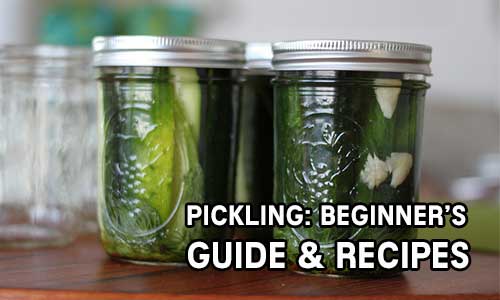Pickling: Beginner’s Guide & Recipes
Who doesn’t love a good pickle on the side of a plate of summer barbecue? Ever thought of making your own pickles? For that matter, how about mastering the techniques of pickling to create tangy and wildly creative side dishes? It’s easier than you think. In essence, a pickle is simply a vegetable soaked in an acid.
In this article, I will introduce how to use vinegar to pickle anything from cucumbers, to green beans, zucchini, carrots, celery, beets, and even some greens. Try some of these techniques and let your creativity run wild! For those less adventurous, I also attached a recipe for what I call the universal pickle. Enjoy!
Choose Your Vinegar
The key ratio for making pickle brine is one part vinegar to one part water. Most vinegar varieties contain the required 5% acidity level, but it is wise to verify this on the label. I recommend the best vinegar you can get, as the quality of vinegar will greatly impact the quality of the brine and pickled items.
Mild white wine vinegar is great for pickling as is lightly sweetened apple cider vinegar. Balsamic vinegar or malt vinegar work well with onions in my experience, while red wine vinegar is great for beets. Avoid basic white vinegar if possible, as the smell and flavor can be very overpowering.
Season to Taste
This is the fun part. Experiment with different combinations of seasonings and spices and fine your own perfect pickle recipe! Salt is a key component for flavor and also keeping vegetables crisp… Beyond that, spice it up with seeds like dill, coriander, cumin, mustard, also black peppercorns, allspice, cinnamon, cloves, and more! There are ready-made pickling spices available at grocery stores which contain combinations of some of these spices. You can also add fresh herbs like basil and tarragon, or a few small onions, a clove of garlic, or a jalapeño pepper for heat. For a touch of sweet, you can also add a little sugar or honey.
Vegetable Prep
Before you get started, make sure your veggies are properly washed and trimmed to your desired size and shape. You can get a little creative here and focus on presentation, making nice neat spears, sticks, slices, etc. Before pickling, vegetables can be cooked, blanched, or left raw, depending on preference. I’ve found different vegetables benefit from different prep methods:
Cucumbers
I generally leave my cucumbers unpeeled. For texture, trim and cut the cucumbers then toss them in 2 tablespoons of kosher salt. Then put them in a colander and cover with 2 trays of ice. After 2 hours, rinse the cucumber pieces and pack them raw.
Green Beans
Try blanching green beans in lightly salted water for 90 seconds than shock in an ice bath to stop the cooking process.
Zucchini and Summer Squash
Zucchini can make perfect pickles. Try adding a pinch of saffron to the brine. For summer squash try cutting them into rounds and salt and drain similarly to cucumbers.
Carrots
Blanch for 2-3 minutes in salted water, then shock carrots in an ice bath before packing.
Garlic and Onions
Ramps, garlic scapes, really any allium make delicious pickles. Cloves of garlic can turn bright colors of blue or green due to a chemical reaction, this is not hazardous and still safe to eat.
Beets
Boil or roast whole beets 30-60 minutes until tender. Slip off skins and cut into convenient pieces for packing.
Greens
You can make good pickles from chard stems, when trimmed into sticks and lightly blanched in salt water. Mixed with coriander seed, Purslane, a wild green succulent also makes wonderful pickles.
Herbs
You can make aromatic vinegar by adding a few fronds of tarragon or Thai basil to a jar of straight, undiluted vinegar.
The Universal Pickle
Yield: 2 Quarts
Ingredients:
• 2 pounds vegetables • 2 cups vinegar of choice
• 2 cups water • 1 tbsp. kosher salt or ½ tbsp. sea salt • 2 whole garlic cloves, peeled and lightly crushed • 4-6 3-inch fronds of fresh dill weed, tarragon, or Thai basil • ½ tsp whole-seed spices such as coriander or mustard and ½ tsp black peppercorns
• options: one teaspoon honey or sugar, four whole cloves, two small dried red chili peppers or a sliced jalapeño, half a dozen pearl onions or two thick slices of shallot
Directions:
1. Trim and slice vegetables to desired size and shape as outlined above.
2. Combine vinegar, water, salt, and sugar or honey (if desired), in a small kettle. Bring to boil and remove from heat.
3. Pack vegetables snugly into clean quart jars while mixing in garlic and fresh herbs. Lastly, add peppercorns, seed spices, peppers, onions, etc. as desired.
4. Bring the brine back to a boil and ladle over vegetables to fill the jar. Seal the jars and let cool overnight. This method followed by refrigeration will keep pickled items for up to a month. Vinegar pickles can also be canned for long-term shelf storage.






